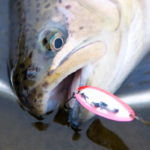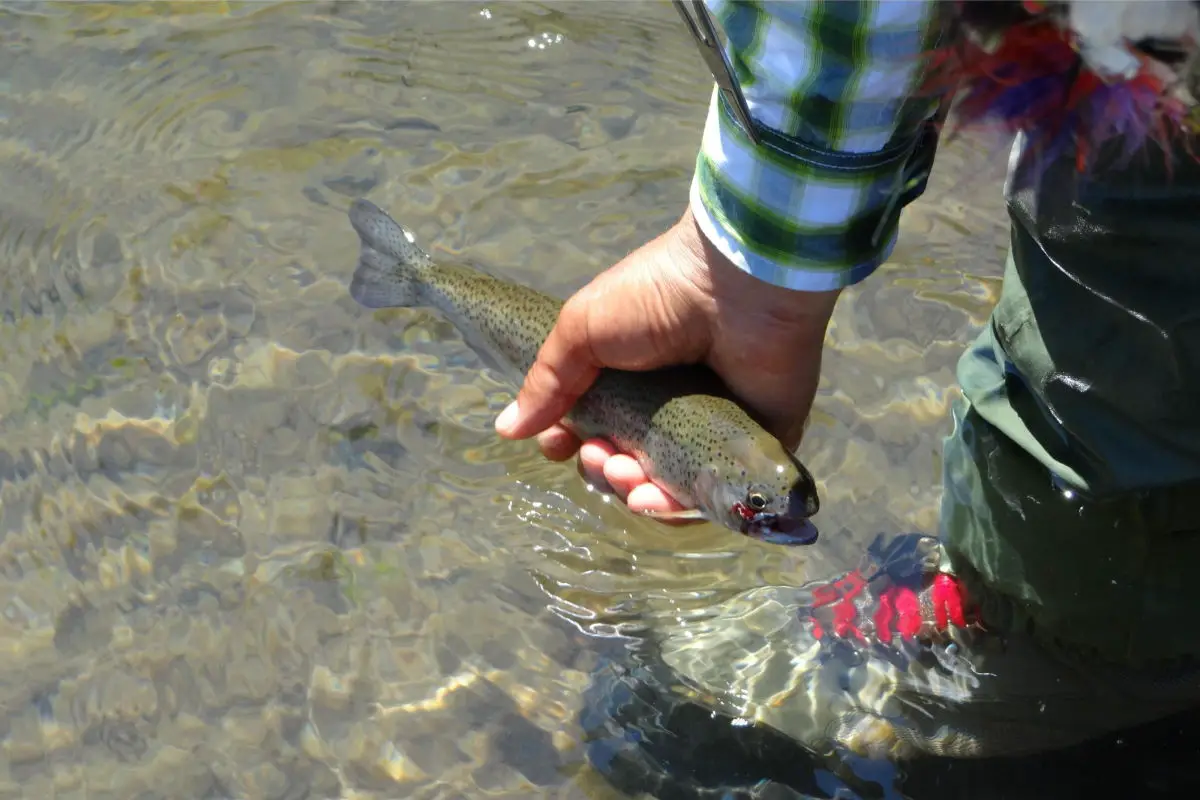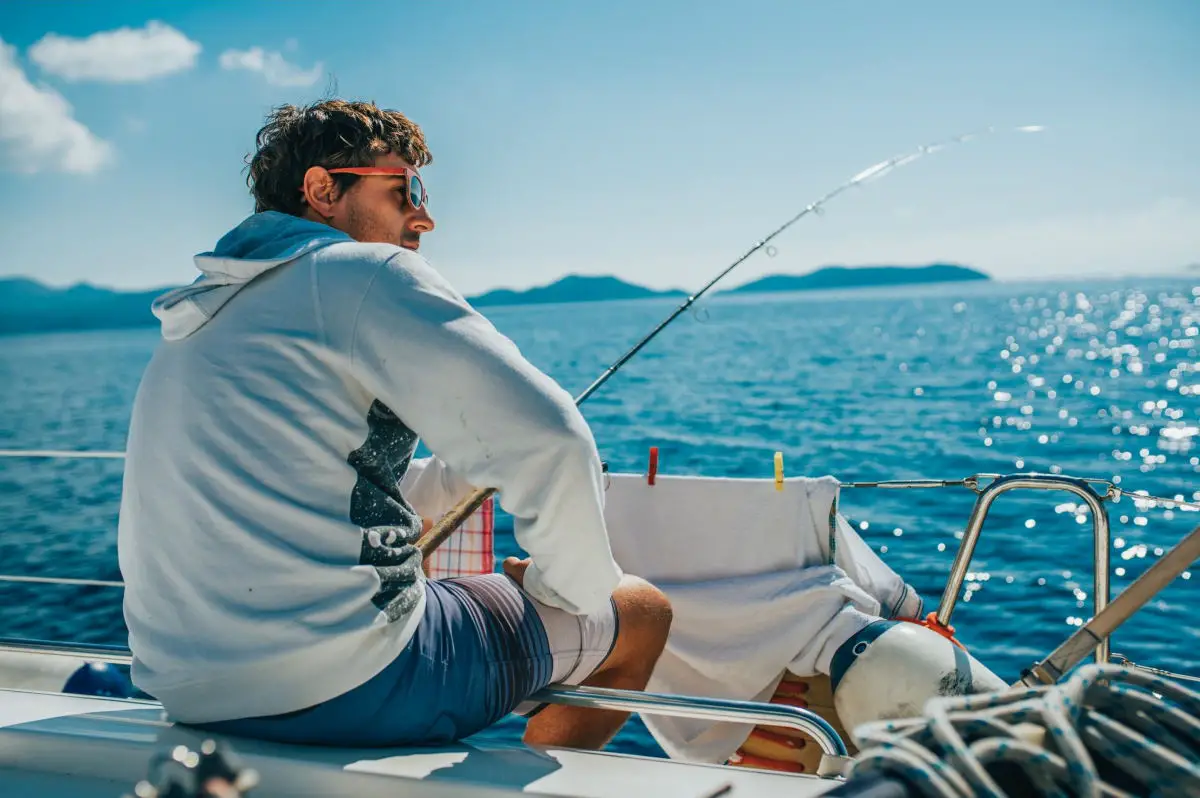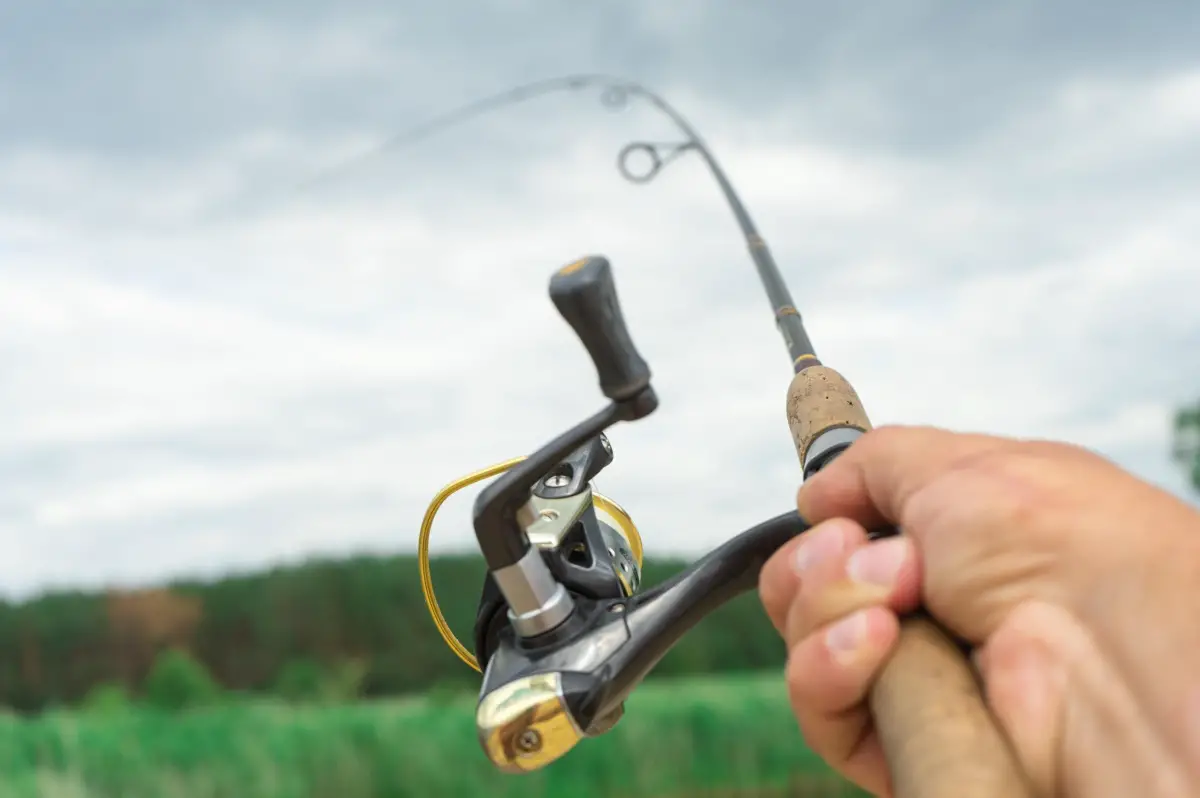When you are looking for a day of fun with low stress, rainbow trout fishing can be one of the easiest things to do. Of course, you can cast a pole from shore and wait for a fish to come by, but I like to chase them down in the boat. Typically, this will involve trolling and using the right gear.
The best lake troll for rainbow trout is a Luhr-Jensen Model A Ford Fender Lake Troll. The 50/50 Brass/Nickel color combination is the most versatile rig if you need to narrow it down to one. However, to make the Ford Fender Lake Troll productive, you need to know how to use it.
In this article, we will tell you how to set it up and give you some tips on how to catch more rainbow trout.
Note: most links in this article are Amazon.com Affiliate links, see Affiliate Disclosure, thank you.

What is a Ford Fender Lake Troll?
A Ford Fender Lake Troll is a two-blade metal flasher on a wire line with a built-in trolling rudder. These lake trolls act as the primary means of attracting fish in large open bodies of water, such as lakes.
The Ford Fender Lake Troll comes in different sizes. Typical sizes are a regular and a mini, which refers to the size of the metal blades.
Different lengths are also available. These lengths range from 13 inches to 22 inches from the front loop to the back loop.
At last check, there were nine blade color combinations in products. These combinations include Solid metal, 50/50 combination, hammered, and stripe paint treatment finishes. Additional, solid metal flasher blades are easy to paint or add your own custom stickers.
The Luhr-Jensen company is owned by Rapala VMC Group, an industry powerhouse. The Acquisition appears to have happened sometime around 2006. Rapala has continued to make the products and maintain good distribution.
What is the Best Rod and Reel for Rainbow Trout Trolling?
Our favorite rod for trout trolling is an Ugly Stik GX2 7’6″ MED-LT Casting Rod with an Okuma Magda 20DLXT line counter reel. This combination will give you great results when trolling for trout but can also be used for many other species, like kokanee.
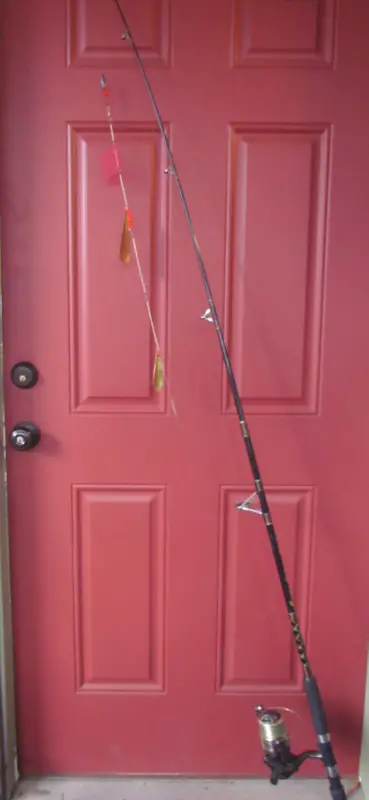
Right off the bat, I want to say that you can use any medium to light equipment to fish for rainbow trout. When trolling, the main factor is a soft enough tip to see the bits. So don’t be scared to use what you have. I have two poles I picked up years ago that I nicknamed clubs and I can’t tell you how many fish they have caught. I do fish these poles sideways out of the boat.
We like the Ugly Stik GX2 because it is firm enough to hold steady while trolling but soft enough to see the change in tip action when you get bit. It can be hard to tell the difference between the lake troll action and a bite resulting in many missed fish on some poles. However, if your pole is too soft, it will bounce around and not let the lake troll work correctly.
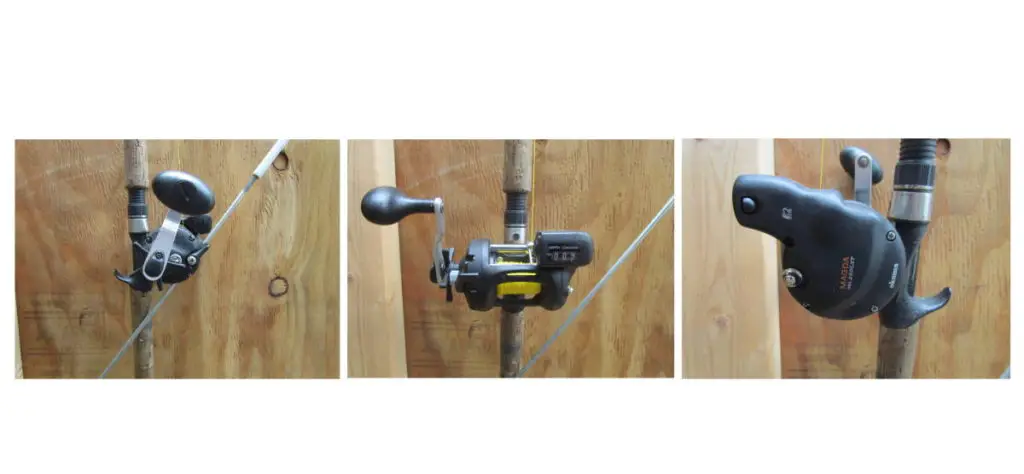
As for the reel, the Okuma Magda series is one of the most budget-friendly reels with a line counter that you can depend on. Our recommended model, the 20DLXT, is a plastic housing, 15-pound drag, left-handed reel. You can also get right-handed if left-handed reels are not your thing, like the 20DXT.
We are loading everything with braided line these days, but you can also use a 12-pound monofilament. Our preferred braid is a 30 pounds yellow hi-vis that we have loaded by our local tackle shop. However, if you want to save a few bucks and know how to get a tight load on your reel, you can purchase KastKing Super Power Braid fishing line.
Finally, consider upsizing your reel to a 30 model, then you will be able to use it for larger fish like steelhead or salmon. Okuma has been making versions of this reel for years, so it is time-tested.
Tip: if the pole you have is too soft, try using a mini-size Ford Fender or troll the softest pole straight out the back of the boat. This will reduce the load on the pole and transfer most of the pressure to the fishing line.
How do I Set Up a Lake Troll for Rainbow Trout?
In some cases, you can attach your Ford Fender Lake troll directly to your main line with a snap swivel. Then add a #6 worm hook with 18 inches of 6-pound monofilament, put on a worm, and you are ready to fish. Of course, there is more to it than that, so let’s break it down.

If you have braid on your main line, you will want to add a bumper or backer on of monofilament to start. Twelve feet of 12-pound Maxima ultra-green line is the perfect bumper to hide your braid and add a bit of flex to your line for soft-biting fish.
Attaching your main line to your bumper line can be done with a few different knots, but we like a standard Uni knot. Then add a small snap swivel to the end of your bumper line for easy rig changes.
Attach the pink rudder end of your Ford Fender Lake troll to the snap swivel. Then add a snap to the other end of the lake troll. Place a swivel on the snap and tie an 18-inch leader, or longer, with a #6 worm hook to the leader.
If you choose to switch to a minnow lure, like a triple teaser, you can disconnect your worm hook leader and connect your premade lure leader in seconds. All that is left to do is slide half a night crawler up the hook, and you are ready to go trolling.
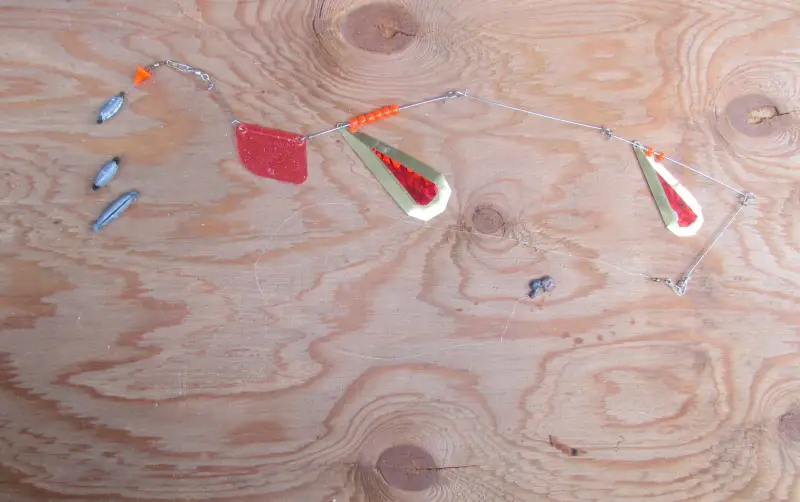
Tip: at the end of every line, we add a snap or a hook. Adding the snap to your lake troll makes it easy to change part of your rigging. Also, add a swivel at the beginning of every rigging or leader so the snap has a connection point.
How Do I Troll for Rainbow Trout with a Ford Fender Lake Troll?
Set your trolling speed to 1 mph and feed out 50 feet of line. Release your line slowly, so you don’t tangle up your lake troll with part of your line. Once your line is tight, carefully place your pole in the rod holder, and you are fishing.
That seems simple, but let’s take a deep dive into the whole process.
As your boat pulls the lake troll through the water, fish from a great distance can see a flashing pattern. Additionally, the flasher’s action also produces a vibration that helps to attract rainbow trout.
The flashing and vibration both change depending on the trolling speed of your boat. A slower speed will generate a slow flash and a thumping action, while a faster rate creates a more rapid flash and a constant vibration.
Trolling speed
The perfect speed for trolling a Ford Fender Lake Troll is 0.95 mph over water. If you are on a lake with little to no current, this might be easy, but you will need to account for that if there is current.
Visually you can tell what speed you are going if you look at the tip of your pole. First, make sure your pole is pointing sideways out of the boat at a 90-degree angle from the back if it is a stiff rod. If you are using a soft rod, a 45-degree angle will work well.
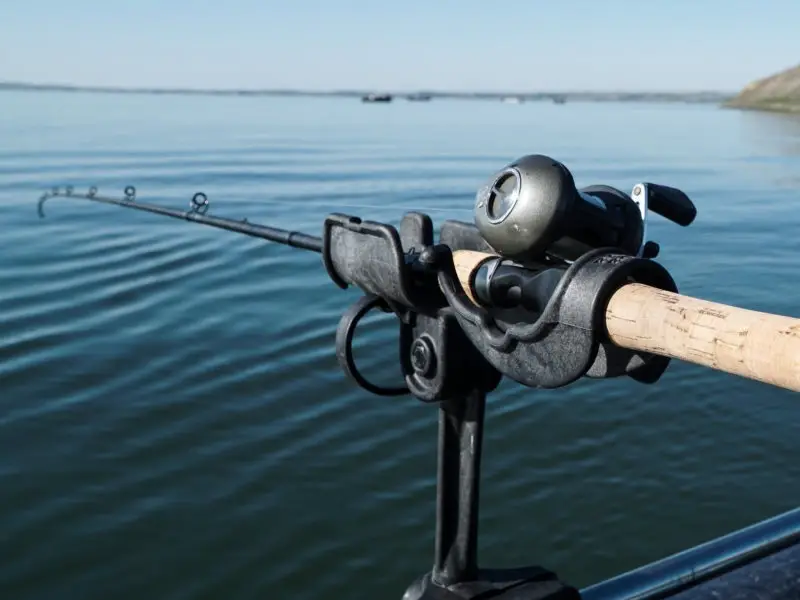
If the pole is pulling hard, you are likely going too fast, over 1.2 mph. A fast, consistent bounce normally indicates a 1.1 to 1 mph speed. Two bounces and a skip should be .9 mph and are on the perfect speed’s lower end. If your line is relatively loose and bounces occasionally, you are likely going too slow.
The perfect speed is two or more bounces with the occasional skip, and then, when you see two or three quick bounces, you have a bit.
Tip: If your having trouble keeping your speed slow enough, consider a sea anchor or a 5-gallon bucket with a few 1-inch holes in the bottom. Tie a 4-foot rope on the bucket’s handle and tie the other end to a back cleat or handle. Toss the bucket in the water, slowing your boat’s speed.
Depth and Weight
Your goal is to troll level with the rainbow trout. The thinking behind this is so your lake troll reflects the sunlight toward the trout to attract them over to your bait.
In a shallow lake, no weight may be required. If your chosen lake is ten feet deep, you will want to skip the weight in most cases. However, a small ¼oz. inline weight might be perfect for preventing your lake troll from breaking the surface, which could mess up your action and scare fish away.
You might want to add up to 2oz. of inline weight in a deep lake to get down where the fish are swimming. However, don’t overdo it, as Ford Fenders are not cheap, and snagging them usually results in losing your fishing gear. Also, most fish will come up a bit to flashers and bait if they know it is there.
Tip: Rubber center weights are great for light trolling rigs. If you buy them slightly smaller than you need, you can use two or three without issue. Inline swivel weights have become more popular recently. Add a snap to one end, add as many as you need to your mainline, and then attach your Ford Fender.
Length of Line or Distance
The standard starting length is 50 feet; however, this can change depending on fishing conditions. If you have clear water with no breeze, you will need to double that length to 100 feet. Doing this will prevent the fish from seeing the boat, reducing the chance of being scared away.
When fishing multiple poles, like four or five, I like to start the side poles at 50 feet of line, 70 feet of line on the corners, and 80 feet of line on the center pole. This seems like a lot, but a good spread helps attract more trout.
Here is a point to combine depth with distance. I will add 1oz of weight to the left side pole and ½oz to the right corner pole. Adding the different weights creates a variation of depth in the flasher pattern. You can add more weight and distance in deep lakes to create more spread between your offerings.

What are good Options to Add a Lure or Spoon?
It can be hard to get the rainbow trout to bite when the sun is high, but a shiny lure, spoon, or rooster tail might do the trick.
Our top lure for rainbow trout trolling is a red-tip copper triple teaser. A triple teaser is a small fish-shaped metal flasher with a hook attached to the end. Trout always respond well to worms, so we like to cover the hook with a small piece of worm, roughly ¼ inch or more.
The next favorite is a dick-nite spoon. The dick nites come in a wide variety of colors and sizes. Also, they can be used to fish for perch, crappie, trout, salmon, and many more species.
Wedding rings are a great mini flasher with formed beads and a little ring that come in the package ready to fish. You attach the included line to the snap swivel, and you are fishing. Wedding rings are also a kokanee favorite when you add shoepeg corn.
Finally, a rooster tail can change your luck on a slow day or when fish are biting softly. Rooster tails come stock with three-point treble hooks, so your odds are better to hook up when you get a bit. However, we don’t recommend fishing these without debarbing the treble if you plan on releasing any fish unharmed.
Our list doesn’t include every option, just the ones we know work. We also hope this gives you some basics for using them.
Conclusion
Now that you know the best lake troll for rainbow trout and how to use it, all that is left is to get out there and catch them. Trout is an easy fish to catch, making them fun for any age.
Also, trout are tasty and good for you. Finally, many lakes with trout are stocked and intended for you to harvest, so you don’t have to worry about sustainability or harm to the environment.

